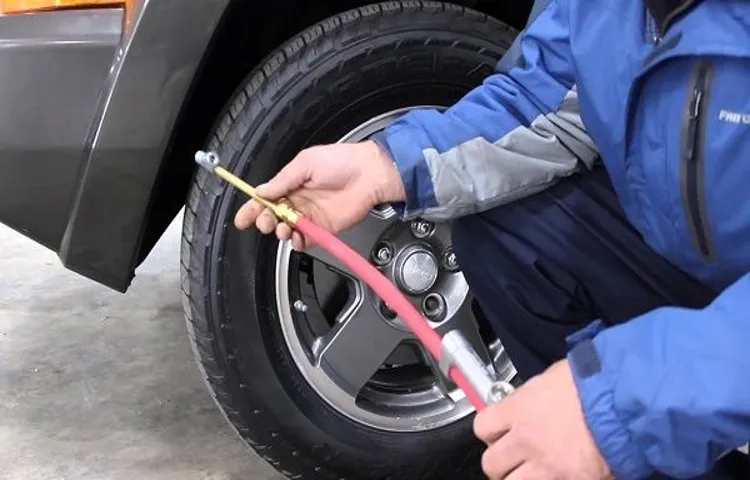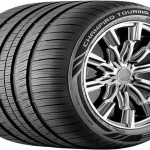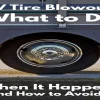Have you ever experienced the frustration of constantly having to refill the air pressure in one of your tires? It’s not only annoying but potentially dangerous. A tire losing air can severely impact your vehicle’s stability and fuel efficiency while also putting you at risk of a blowout. There are a few reasons why one tire may keep losing air, each with its own set of solutions.
Whether it’s a puncture, valve stem issue, or corrosion on the wheel, we’ve got you covered on how to fix it. In this blog post, we’ll explore the causes and solutions to help keep your tires properly inflated and safe for the road ahead.
Table of Contents
Introduction
Have you noticed that one of your tires is constantly losing air? This can be a frustrating and potentially dangerous situation for drivers. There are many possible reasons why your tire may be losing air, but the most common cause is a puncture or leak. In some cases, a nail or other sharp object may have punctured the tire.
Alternatively, the valve stem may be damaged or faulty, causing air to leak out slowly over time. Poor tire maintenance, such as under-inflating or over-inflating the tire, can also cause air loss. Regardless of the cause, it is important to address the problem promptly to avoid further damage to your vehicle or potential safety hazards on the road.
A tire professional can inspect the tire and recommend the best course of action, whether that means a simple repair or a complete replacement. So if you notice that your tire is losing air, don’t ignore it – schedule an appointment with a tire expert right away.
The importance of tire pressure
Tire pressure is one of the most crucial aspects of maintaining your vehicle’s safety and performance. Not only does it impact your car’s fuel efficiency and handling, but it can also affect your ability to stop quickly on wet or slippery roads. That’s why it’s critical to check your tire pressure regularly and ensure that it’s in line with your manufacturer’s recommendations.
It’s also important to note that tire pressure can fluctuate with changes in temperature, so be sure to monitor it throughout the year, not just during the winter months or summer heatwaves. By taking the time to keep your tires properly inflated, you can help maximize your car’s performance and protect yourself and your passengers while on the road.

Common causes of air loss in tires
As car owners, it’s important to stay on top of our vehicle’s tire maintenance. Checking the tire pressure regularly can help save fuel and increase the lifespan of the tires. However, despite our best efforts, air loss in tires is a common occurrence that we have all faced at some point.
There are many factors that could lead to air loss in the tires, including punctures, valve damage, and corrosion. But the most overlooked cause of air loss is permeation, which is the natural escape of air through the rubber compound of the tire itself. To combat this, tire manufacturers have begun developing advanced rubber compounds that help reduce permeation, but it still remains a common issue that we must address.
Regularly checking our tire pressure and being aware of these common causes of air loss can go a long way towards avoiding accidents and ensuring optimal performance on the road.
Possible solutions to fix a leaking tire
A leaking tire can be a frustrating experience that can leave you stranded on the side of the road. However, there are several possible solutions to fix a leaking tire depending on the cause and severity of the leak. One solution is to use a tire sealant, which is a liquid that can temporarily fill small punctures in the tire.
Another option is to replace the tire valve stem, as a faulty valve stem can lead to air leaks. Sometimes, a leaking tire may require a patch or plug, particularly if the puncture is large or located on the sidewall of the tire. If the tire is severely damaged or has sustained multiple punctures, it may need to be replaced altogether.
It’s important to address a leaking tire promptly to avoid the risk of a blowout or other hazardous situations. At the first sign of a leak, check your tire pressure and inspect the tire for any visible damage. If you’re unsure about how to proceed, it’s always best to seek professional help from a tire specialist.
Testing and Diagnosis
If you’re experiencing a flat or slowly deflating tire, then it’s likely that you have a puncture hole or leak somewhere in the tire. In some cases, your tire may keep losing air due to a faulty valve stem or rust around the rim, which can cause air to escape. It’s also possible that your tire has a bad bead seal, which can lead to decreased air retention.
If you’ve ruled out punctures, then consider these possibilities and have your tire inspected by a professional mechanic. They will likely run some basic tests to determine the root cause of the issue. Having a leaking tire can be frustrating and even dangerous, so don’t ignore it.
Keep your vehicle well-maintained and always be vigilant about checking your tire pressure and tread depth. If you notice a problem, it’s best to address it as soon as possible.
Visual inspection of the tire
When it comes to testing and diagnosing the condition of your tire, it’s essential to start with a visual inspection. By thoroughly examining your tire’s surface and side walls, you can identify any visible abnormalities or defects that may be affecting its performance. Look out for cuts, bulges, or punctures – all of which can lead to tire failure and compromise your safety on the road.
Also, check to see if your tires have worn unevenly, which can be a sign of misalignment or a suspension problem in your vehicle. If you notice any of these issues during your visual inspection, it’s imperative to get your tire looked at by a professional mechanic or replaced altogether. Remember to conduct routine visual inspections of your tires to catch any problems early on before they cause a potential blowout or accident on the road.
So, the next time you’re due for a tire check-up, make sure not to skip the visual inspection!
Checking the valve stem and core
When it comes to testing and diagnosing issues with your tires, checking the valve stem and core is an important step to take. The valve stem is the part of the tire that allows for inflation and deflation, while the valve core is an inner component that helps to control the flow of air. If the valve stem is damaged or leaking, it can cause your tire to lose air pressure and can even lead to a flat tire.
To check the valve stem and core, start by examining the valve cap and making sure it is securely tightened. Then, remove the cap and use a tire pressure gauge to check the air pressure. If the pressure is too low, use an air compressor to inflate the tire to the appropriate level.
Finally, use a valve core tool to remove the valve core and inspect it for damage or wear. If you notice any issues with the valve stem or core, it’s best to replace them to avoid further problems down the road. By taking the time to check the valve stem and core, you can ensure that your tires are performing at their best and keep yourself safe on the road.
Testing the tire for punctures or damages
When it comes to driving, one of the most important factors to consider is the state of your tires. If you notice that your car is constantly drifting or pulling to one side, or you hear strange noises, it may be an indicator that your tire has been punctured or damaged. The first step in diagnosing a potential issue with your tire is to visually inspect your tire for any signs of wear and tear.
If you see any visible damage, such as cuts or punctures, it is imperative to address the issue as soon as possible. But visual inspection alone is often not enough to diagnose the problem. To be absolutely sure, you should conduct a thorough tire test.
A simple way to test your tire for leaks is to spray soapy water on the tire. If you see any bubbles forming, that is a clear indication that there is a leak somewhere. You can also use a tire pressure gauge to measure the air pressure in your tire.
A noticeable drop in air pressure can also indicate a puncture or leak. It is crucial that you address any punctures or damages right away. Neglecting these issues can lead to catastrophic tire failure, which can be extremely dangerous while driving.
It is vital that you take good care of your tires to ensure the safety of yourself and other drivers on the road. So, if you notice any issues with your tire, be sure to have it checked out by a professional as soon as possible. Always keep in mind that prevention is better than cure, so regular maintenance and inspection is key to keeping your car and its tires in top condition.
Prevention and Maintenance
Have you ever wondered why one tire keeps losing air despite adding air frequently? Well, there could be several reasons for this issue. One of the most common reasons is a damaged or punctured tire. A small hole or cut in the tire can cause it to lose air slowly, which may require repair or replacement.
Another reason could be a faulty valve stem. Valve stems are responsible for maintaining the tire pressure and can get damaged over time, causing air leakage. Additionally, corrosion or damage to the rim can cause the tire to lose air.
Neglecting to perform routine maintenance, such as checking tire pressure, can also lead to air loss. Therefore, it is important to regularly check your tire pressure, inspect the tires, and perform preventive maintenance to avoid this issue. If you notice a persistent air loss in one tire, it’s best to have a professional mechanic inspect it to identify the root cause and make necessary repairs.
Regular tire pressure checks
Regular tire pressure checks are an essential part of vehicle maintenance to ensure optimal performance and longevity of your tires. By maintaining the correct tire pressure, you can avoid potential hazards, such as blowouts or uneven wear, which can be caused by underinflated or overinflated tires. Moreover, driving on improperly inflated tires can decrease your fuel efficiency and overall handling, which can directly impact your safety on the road.
To avoid these issues, it’s recommended that you check your tire pressure at least once a month or before any long road trip. You can easily check the correct pressure by referring to your vehicle owner’s manual or the tire placard located on the driver’s side door jamb. Making a habit of checking your tire pressure can save you from costly repairs, minimize the risk of accidents, and ultimately increase your vehicle’s lifespan.
So, don’t neglect this important aspect of car maintenance and keep your tires in top shape!
Proper tire installation and balancing
Proper tire installation and balancing is vital for smooth and safe driving. Tire punctures, tread wear, or bursting can cause accidents and injuries if not checked properly. Therefore, prevention and maintenance are crucial to avoid such situations.
Regularly inspect the tires for any signs of damage, such as cracks or bulges, and address them immediately. An expert technician should install the tires correctly, ensuring they are properly aligned, balanced, and torqued. They can also help you select the right kind of tires based on your driving habits and climatic conditions.
Proper balancing ensures even weight distribution and reduces the chances of vibrations, which can compromise driving stability and comfort. Also, ensure that your tires are rotated regularly to maintain consistent wear levels. In summary, proper tire installation and balancing are essential to keep you and your passengers secure on the road.
Conclusion
Well folks, it seems we’ve reached the end of our investigation into why one tire keeps losing air. And the answer? Well, it’s simple really: air leakage. But before you roll your eyes at the obviousness of it all, let’s dive a bit deeper.
You see, air leakage isn’t just a physical phenomenon, it’s a metaphor for life. Just like a tire, we all have our own leaks and imperfections. But instead of constantly filling ourselves up with air (or positivity, or ambition, or any other metaphorical substance), we should strive to find and fix our leaks.
Only then can we truly reach our full potential and avoid the endless cycle of deflation. So the next time you find yourself with a flat tire, remember to look inward and ask yourself, where are my leaks and how can I fix them?”
FAQs
Why does my tire keep losing air?
Your tire may be losing air due to a puncture, a leaking valve stem, or a damaged wheel.
How do I know if my tire is losing air?
You may notice your tire appearing flatter than usual, your vehicle may be pulling to one side, or you may hear a hissing noise.
Can I still drive with a tire that is losing air?
It is not recommended to drive with a tire that is losing air as it can lead to tire failure, poor vehicle handling, and decreased fuel efficiency.
How often should I check my tire pressure?
It is recommended to check your tire pressure at least once a month and before long drives.
What can I do to prevent my tire from losing air?
Regularly checking your tire pressure, avoiding potholes and debris on the road, and maintaining good tire health can prevent your tire from losing air.
Is it safe to inflate my tire with fix-a-flat?
Fix-a-flat is a temporary solution and should not be used as a long-term fix for a flat tire. It is best to seek professional assistance for tire repairs or replacements.
What is the proper way to inflate my tire?
Follow the PSI (pounds per square inch) recommendation listed in your vehicle’s owner manual or on the tire itself. Use a tire pressure gauge to ensure proper inflation.



